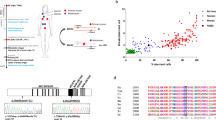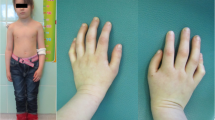Abstract
Fanconi anaemia (FA) is a genotypically and phenotypically heterogeneous genetic condition, characterized cytogenetically by chromosomal instability and breakage secondary to impaired DNA repair mechanisms. Affected individuals typically manifest growth restriction and congenital physical abnormalities and most progress to hematological disease including bone marrow aplasia. A rare genetic subtype of FA (FA-D1) is caused by biallelic mutations in the BRCA2 gene. Affected individuals manifest severe congenital anomalies and significant pigmentary changes and are additionally at risk for early onset leukemia and certain solid organ malignancies, including Wilms tumors and brain tumors. Parents of affected individuals are obligate carriers for heterozygous BRCA2 mutations and are thus potentially at risk for adult onset cancers which fall within the hereditary breast and ovarian cancer spectrum. We present two cases of black South African patients with FA diagnosed with biallelic BRCA2 mutations and discuss the phenotypic consequences and implications for them and their families. Recognition of this severe end of the phenotypic spectrum of FA is critical in allowing for confirmation of the diagnosis as well as cascade screening and appropriate care of family members.


Similar content being viewed by others
References
Alter B, Kupfer G (2013) “Fanconi Anaemia”. Gene reviews. Last updated February http://www.ncbi.nlm.nib.gov/books/NBK1401
Morgan NV, Essop F, Demuth I et al (2005) A common Fanconi anaemia mutation in black populations of sub-Saharan Africa. Blood 105:3542–3544
Tipping AJ, Pearson T, Morgan NV et al (2001) Molecular and genealogical evidence for a founder effect in Fanconi anaemia families of the Afrikaner population of South Africa. Proc Natl Acad Sci USA 98:5734–5739
Ameziane N, May P, Haitjema A et al (2015) A novel Fanconi anaemia subtype associated with a dominant-negative mutation in RAD51. Nat Commun 6:8829
Sawyer SL, Tian L, Kahkonen M et al (2015) Biallelic mutations in BRCA1 cause a new Fanconi anaemia Subtype. Canc Discov 5(2):135–142
Bluteau D, Masliah-Planchon J, Clairmont C et al (2016) Biallelic inactivation of REV7 is associated with Fanconi anaemia. J Clin Investig (Epub 2016 Aug 8)
Park JY, Virts EL, Jankowska A et al (2016) Complementation of hypersensitivity to DNA interstrand crosslinking agents demonstrates that XRCC2 is a Fanconi anaemia gene. J Med Genet 53(10):672–680
De Winter JP, Joenje H (2009) The genetic and molecular basis of Fanconi anaemia. Mutat Res 668:11–19
Mathew CG (2006) Fanconi anaemia genes and susceptibility to cancer. Oncogene 25:5875–5884
Faivre L, Guardiola P, Lewis C et al (2000) Association of complementation group and mutation type with clinical outcome in Fanconi anaemia. Blood 96:4064–4070
Hirsch B, Shimamura A, Moreau L et al (2004) Association of biallelic BRCA2/FANCD1 mutations with spontaneous chromosomal instability and solid tumors of childhood. Blood 103(7):2554–2559
Wagner JE, Tolar J, Levran O et al (2004) Germline mutations in BRCA2: shared genetic susceptibility to breast cancer, early onset leukemia, and Fanconi anaemia. Blood 103(8):3226–3229
Reid S, Renwick A, Seal S et al for the Familial Wilms Tumour Collaboration (2005) Biallelic BRCA2 mutations are associated with multiple malignancies in childhood including familial Wilms tumour. J Med Genet 43:147–151
Meyer S, Tischkowitz M, Chandler K et al (2014) Fanconi anaemia, BRCA2 mutations and childhood cancer: a developmental perspective from clinical and epidemiological observations with implications for genetic counselling. J Med Genet 51:71–75
Feben C, Kromberg J, Wainwright R et al (2014) Phenotypic consequences in black South African Fanconi anaemia patients homozygous for a founder mutation. Genet Med 16(5):400–406
Feben C, Kromberg J, Wainwright R et al (2015) Haematological consequences of a FANCG founder mutation in black South African patients with Fanconi anaemia. Blood Cells Mol Dis 54:270–274
Kim H, D’Andrea AD (2012) Regulation of DNA cross-link repair by the Fanconi anaemia/BRCA pathway. Genes Dev 26:1393–1408
Tischkowitz M, Xia B (2010) PALB2/FANCN–recombining cancer and Fanconi anaemia. Cancer Res 70(19):7353–7359
Van der Merwe NC, Hamel N, Schneider SR et al (2012) A founder BRCA2 mutation in non-Afrikaner breast cancer patients of the Western Cape of South Africa. Clin Genet 81:179–184
Zierhut HA, Tyron R, Sanborn EM (2014) Genetic counseling for Fanconi anaemia: crosslinking disciplines. J Genet Couns 23:910–921
Wainstein T (2011) Family history and risk assessment in black South African women with breast cancer (MSc dissertation). Retrieved from: http://hdl.handle.net/10539/11052
Parsons MT, Whiley PJ, Beesley J et al (2015) Consequences of germline variation disrupting the constitutional translational initiation codon start site of MLH1 and BRCA2: use of potential alternative start sites and implications for predicting variant pathogenicity. Mol Carcinog 54:513–522
Francies FZ, Wainstein T, de Leeneer K et al (2015) BRCA1, BRCA2, and PALB2 mutations and CHEK2 c.1100delC in different South African ethnic groups diagnosed with premenopausal and/or triple negative breast cancer. BMC Cancer 15:912
Acknowledgements
We would like to thank Dr Brian Wilson and his team (Northern Molecular Genetics Service) for their assistance in providing molecular genetic testing for KB and the Molecular Genetics Laboratory of the University of the Free State for BRCA2 genetic testing in relatives of KB and LS. FANCG mutation analysis was performed by the Molecular Genetic Laboratory of the Division of Human Genetics at the National Health Laboratory Services, Braamfontein. We thank the families involved for their permission to use their information.
Author information
Authors and Affiliations
Corresponding author
Ethics declarations
Conflict of interest
The authors declare no conflict of interest.
Ethics approval
Ethics approval for this case study was obtained from the Human Research Ethics Committee of the University of the Witwatersrand.
Rights and permissions
About this article
Cite this article
Feben, C., Spencer, C., Lochan, A. et al. Biallelic BRCA2 mutations in two black South African children with Fanconi anaemia. Familial Cancer 16, 441–446 (2017). https://doi.org/10.1007/s10689-017-9968-y
Published:
Issue Date:
DOI: https://doi.org/10.1007/s10689-017-9968-y




